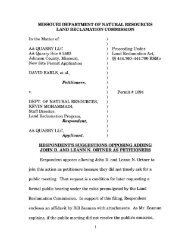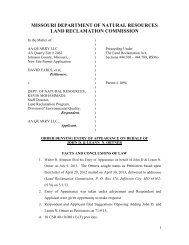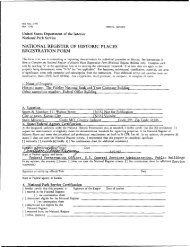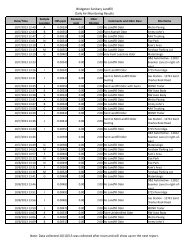Winter 2006 - Missouri Department of Natural Resources
Winter 2006 - Missouri Department of Natural Resources
Winter 2006 - Missouri Department of Natural Resources
You also want an ePaper? Increase the reach of your titles
YUMPU automatically turns print PDFs into web optimized ePapers that Google loves.
By using a pump drill to<br />
place holes in freshwater<br />
mussel shells, participants<br />
learned not only an ancient<br />
technique, but also how<br />
important the shells were<br />
in jewelry making and<br />
other crafts.<br />
4 <strong>Missouri</strong> <strong>Resources</strong><br />
Seasonal naturalists come from either<br />
a scientific or historical background, from<br />
all walks <strong>of</strong> life, from college age to near<br />
retirement. Some <strong>of</strong> these seasonal employees<br />
return each summer; others are new,<br />
having been hired as a result <strong>of</strong> the many recruitment<br />
events Kastler conducts on college<br />
campuses across <strong>Missouri</strong> each spring.<br />
No matter the age or the experience, the interpreters<br />
benefit from the annual Interpreters<br />
Training School conducted before<br />
the start <strong>of</strong> each season. In addition, some<br />
<strong>of</strong> <strong>Missouri</strong>’s state historic sites routinely<br />
send their full-time and seasonal interpreters<br />
to the training school.<br />
For the past several years, a 10-person<br />
training committee <strong>of</strong> pr<strong>of</strong>essional interpreters<br />
has organized and planned each<br />
year’s curriculum. Kastler serves as chairman<br />
<strong>of</strong> the committee, composed <strong>of</strong> state<br />
parks, U.S. Army Corps <strong>of</strong> Engineers and<br />
<strong>Department</strong> <strong>of</strong> Conservation staff.<br />
MDC photo by John Miller<br />
The 40-hour training, held at Dr.<br />
Edmund A. Babler Memorial State Park in<br />
Wildwood, is broken down into basic, intermediate<br />
and advanced studies, as well as<br />
specialized coursework. The goal <strong>of</strong> the<br />
school is to teach innovative, fun and creative<br />
program ideas that turn the unknown<br />
into the understandable in a way that will<br />
fascinate and arouse the park visitor, leaving<br />
a lasting appreciation <strong>of</strong> natural and cultural<br />
topics.<br />
First-year trainees are instructed in interpretation<br />
philosophy, theme development,<br />
writing, program development, logistics<br />
and formats development.<br />
Second-year trainees have a short review <strong>of</strong><br />
these topics and receive training from a cultural<br />
perspective. Courses include caring<br />
for artifacts and living history interpretation.<br />
Third-year (or higher) trainees are certified<br />
in national programs dealing with outdoor<br />
ethics and environmental education.<br />
A fourth section was added in 2005 for<br />
anyone interested in pursuing a pr<strong>of</strong>essional<br />
career in interpretation. Participants are<br />
taught by division staff and receive certification<br />
as Pr<strong>of</strong>essional Interpretive Guides<br />
from the National Association for Interpretation,<br />
an organization dedicated to advancing<br />
interpretation as a pr<strong>of</strong>ession.<br />
In addition to classroom sessions, there<br />
are a lot <strong>of</strong> hands-on activities such as a<br />
19th century version <strong>of</strong> baseball. There are<br />
more than two dozen demonstrations showcased<br />
at the “Kaleidoscope,” a two-andone-half-hour<br />
event covering a broad range<br />
<strong>of</strong> subjects such as geology, botany, zoology,<br />
shell carving, crafts and timber framing.<br />
Stations boast names such as “Hug a Herp,”<br />
“Can I Touch It?,” “It’s a Buggy, Buggy<br />
Day,” “The Crafty Couple,” and “The Interpreters’<br />
Tapestry <strong>of</strong> Beauty.”<br />
Not all <strong>of</strong> the fun and education occurs<br />
between 8 a.m. and 5 p.m. Nighttime segments<br />
demonstrate popular park programs<br />
such as astronomy, night hikes, spider sniffs<br />
and owl prowls.<br />
All basic and intermediate-level students<br />
demonstrate the skills they have learned by<br />
presenting a short program. They also are<br />
tested on their knowledge <strong>of</strong> <strong>Missouri</strong> natural<br />
and cultural history. At the conclusion <strong>of</strong><br />
the training school, each participant receives<br />
a certificate <strong>of</strong> training. Special<br />
recognition is given to the best effort<br />
demonstrated at all three levels. Approximately<br />
100 people attend the Interpreters<br />
DNR photo by Scott Myers

















